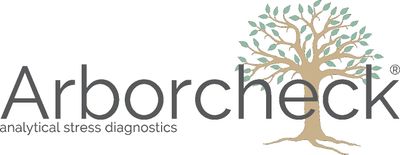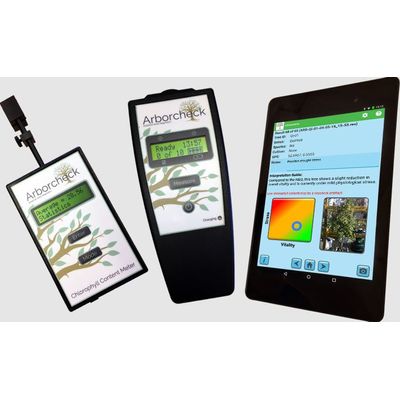


Arborcheck - Tree Vitality Monitoring & Stress Detection System
Arborcheck is a cost effective system providing arboricultural professionals with a convenient method of assessing the impact of stress on overall tree vitality. The system consists of 2 hand-held instruments which test different physiological characteristics of the leaf providing a detailed evaluation of the physiological performance of the tree. Results may be used as an indication of the early stages of decline due to stress or as supporting evidence for the findings of Visual Tree Assessments.
Arborcheck employs research techniques that are used widely by scientists all over the world as a means of detecting physiological damage caused by biotic or abiotic stress factors.
Chlorophyll fluorescence is a measurement of far-red light that is re-emitted from within the leaf itself. This light is a dissipation of energy that could not be used by the leaf in the early reactions of photosynthesis. An increase in the intensity of chlorophyll fluorescence indicates the presence of stress factors that are limiting the trees ability for optimum photosynthesis.
Chlorophyll content is a very simple optical measurement which provides a reading of relative chlorophyll content. Stress limits the amount of carbohydrates available for growth and reduces nutrient uptake resulting in leaf chlorosis and necrosis. Exact knowledge of foliar chlorophyll concentrations, i.e. leaf greenness, consequently helps to provide a robust and accurate estimation of tree vitality.
Both instruments are non-invasive, non-destructive and allow measurements to be taken directly on the tree in situ. Each measurement takes no more than 1 second to complete.
Photosynthesis can be inhibited by different stress factors in a variety of ways. Issues such as drought and nutrient deficiency starve the tree of raw materials required for photosynthetic processes to occur whilst stress caused by herbicide damage can physically break down the structures within the leaf itself.
Any of these factors can mean that the leaf is unable to photosynthesize at an optimum rate and the amount of light energy from the sun that the leaf is able to receive and process is reduced. Chlorophyll fluorescence is the method used by the leaf to dissipate the excess energy that cannot be used. Elevated stress on the tree means reduced photosynthetic activity and higher chlorophyll fluorescence emission.
For visual damage to occur, the leaf must go through a series of physiological processes starting with inhibition of photosynthesis and ultimately leading to leaf necrosis. This may take anything from a few days to several weeks depending on the type or combination of stress factors involved. Changes in chlorophyll fluorescence emission occur at the very start of this chain of events at the point where photosynthesis is inhibited. This allows Arborcheck to be highly effective in detecting stress and reduced vitality levels sometimes weeks before any visual symptoms are apparent.
The real power of Arborcheck lies in its ability to analyse recorded data from a particular tree against a species-specific Database of Benchmark Values (DBV) for chlorophyll fluorescence and chlorophyll content.
Independent collection of the DBV data has taken place annually since 2009 by Bartlett Tree Research Laboratories from trees at Barcham Trees Nursery, the largest containerised tree nursery in Europe. Barcham originally began collecting data to offer an additional level of quality assurance to customers by providing evidence of good physiological tree health.
Leaves from several individual trees within a species/cultivar are tested for both chlorophyll fluorescence and chlorophyll content before being sent to a lab where they undergo an additional procedure known as electrolyte leakage which tests for cell wall integrity. The results of these measurements are analysed by Dr. Glynn Percival and his colleagues at Bartlett to determine the overall health and vitality of the stock on the nursery. Thanks to the strict production models employed by Barcham, the stock has been verified by Bartlett as being in optimum physiological condition.
This extensive data set is collated and integrated into Arborcheck to provide the DBV. The current database contains benchmark values for almost 400 individual species/cultivar.
Strict data collection policy
Data is collected using robust, peer reviewed research techniques according to a strict set of procedures so that we are able to guarantee that the DBV can be described as optimum. We only collect data from containerised trees since this method of nursery production offers as near as possible a perfectly controlled growth environment. For all tree types, we collect 2 years worth of data for chlorophyll fluorescence, chlorophyll content and an additional laboratory research technique called electrolyte leakage before adding the species/cultivar to the DBV. Data collection is overseen at every stage by researchers from Bartlett Tree Research Laboratories in the UK with data analysis carried out by some of the worlds leading researchers in arboriculture to ensure that the consistency and integrity of the DBV is maintained.
Ongoing data collection
Each year, the data collection exercise not only adds to the list of supported trees as new species are added to the Barcham stock list but also serves to increase the robustness of the existing datasets. The DBV currently contains almost 400 individual tree species/cultivar that Barcham Trees are able to grow in the temperate British climate. Whilst this covers a large geographical area (UK and much of Europe), as a commitment to supply Arborcheck to arborists all over the world, we have commissioned reputable independent consultants to collect data from hand-picked nurseries with projects currently ongoing in Australia, New Zealand, Hong Kong and the United States of America to screen species from different climatic regions.
Data from the leaf fluorescence and chlorophyll content measurements is presented by the Arborcheck app for both overall tree vitality and current stress levels. Vitality is calculated from 2 parameters; photosynthetic efficiency and chlorophyll content with stress calculated from 4 additional stress indicator (Si) parameters taken from the leaf chlorophyll fluorescence measurements.
Results are displayed both as a graphical summary of vitality and stress and also as a more detailed presentation of the standard deviation from the DBV for each of the individual parameters.
The app also displays a text interpretation of the data which can indicate slight, significant, critical or no reduction in overall vitality with mild, moderate, severe or no current physiological stress levels.
Arborcheck is also supplied with Report Generation Software. This program has been designed to take results files that have been copied from the tablet to a PC and compile them in to a rudimentary appendix to an existing client report proforma that can be printed either physically or to a PDF document (a 3rd party PDF generator like CutePDF may be required).
